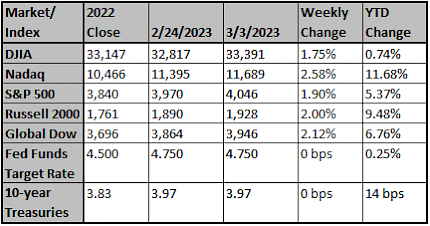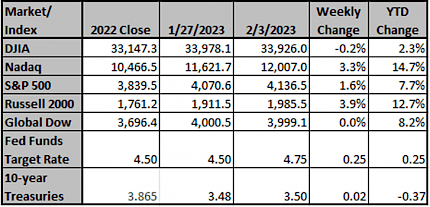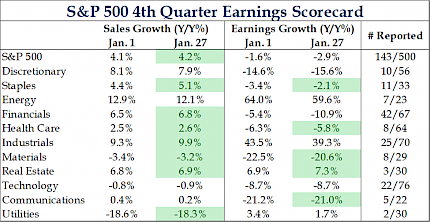As we are sure you have seen, the FDIC stepped in to take over Silicon Valley Bank (SIVB) over the weekend. First and foremost, we want to assure that your assets at Charles Schwab are safe and secure. To begin, we want to highlight a key difference between investment (brokerage accounts) and bank deposit accounts. Investment accounts are held in trust name for a client’s benefit. The assets are not comingled with the brokerage company’s assets. Because of this, if the brokerage company we… View More
Authors
Post 151 to 160 of 595
U.S. equities were higher last week (S&P 500 +1.9%) after three weeks of declines. Markets continued to reprice upward Fed rate expectations. Best sectors were materials (+4.0%), communication services (+3.3%) and industrials (+3.3%); worst performers were utilities (-0.7%) and consumer staples (-4.0%). 1. There is clearly not yet enough progress on inflation to satisfy the Fed which means higher risk of ongoing hikes. This factor coupled with declining money supply and the inverted yield c… View More
Dear Clients, Today is the 1st Annual Coachella Valley Giving Day. CV Giving Day brings the region together as one community, raising money and awareness for local nonprofits in the Coachella Valley. Fortem Financial is a long-time supporter of the local non-profit, Martha's Village & Kitchen, where their mission is transforming lives of the impoverished and homeless. All donations made today up to $20,000.00 will be matched. Visit the Martha's donation page here: CV Giving Day Martha'… View More
"There are two types of economists," said famed economist John Kenneth Galbraith, "those who don't know, and those who don't know they don't know." This, along with movie producer William Goldman's assertion that "nobody knows anything" are two quotes that remind us to be humble when making forecasts about the future path of the economy and the financial markets. To the extent to which economics will always be a social science and never a hard science like, let's say, chemistry, it is incumbent … View More
U.S. equities were mixed last week (S&P 500 -0.2%) with some early week strength surrendered in multiple risk-off sessions impacted by economic data and hawkish Fed commentary. Fed peak rate expectations moved higher on a stronger than expected inflation report. Best sectors were consumer discretionary (+1.7%), consumer staples (+0.9%), and utilities (+1.1%); worst sectors were energy (-6.5%), REITs (-1.3%), and materials (-0.9%). Source: Bob Doll, Crossmark Investments Chart r… View More
In observance of Presidents' Day, the New York Stock Exchange and bond markets are closed on Monday, February 20, 2023. Our office will be closing at 1:00PM PST on Friday, February 17, 2023, and will reopen on Tuesday, February 21, 2023, at 6:30AM PST. Sincerely, Fortem Financial(760) 206-8500team@fortemfin.com … View More
U.S. equities closed lower last week as the S&P 500 (-1.1%) fell for the first time in three weeks and Nasdaq (-2.4%) in six weeks. WTI crude was up 8.6%, the best week since early October. Treasuries turned into a headwind due to a repricing of the Fed rate path. The only positive sector was energy (+5.0%); the worst sector was communication services (-6.6%) due in part to Google (-9.7%). Source: Bob Doll, Crossmark Investments Chart reflects price changes, not total return. B… View More
We first became cautious on future market returns last March and have remained so ever since. Despite some countertrend rallies after the market peaked at 4,797 on January 3, 2022, we continue to believe that the inversion of the yield curve, aggressive Fed tightening, and the likelihood of a decline in corporate profits renders the chances of recession by the end of 2024 at about 3 in 4. Having said that, the tape and the economic data over the past month suggest that a recession is unlikely t… View More
The Fed downshifted to a smaller rate hike to start 2023, but the job is far from done. As expected, the Fed raised rates by 25 basis points (bp) today, slowing from the 50bp hike in December, and the 75bp hikes at the four meetings before that. However, the Fed continued to reiterate that ongoing tightening is warranted and repeated the view that the risk to doing too little is greater than the risk of doing too much. While we have to wait for March to get updated forecasts from the Fed (the d… View More
U.S. equities finished higher last week (S&P 500 +2.5%), closing above the 4000 level for the first time since early December. The path of least resistance remains higher even though earnings season continued to undershoot expectations. Best sectors were consumer discretionary (+6.4%) and technology (+4.1%); worst sectors were healthcare (-0.9%) and utilities (-0.5%). 4Q Reporting Season Continues To Underwhelm The 4Q reporting season continues to underwhelm with earnings growth expec… View More








